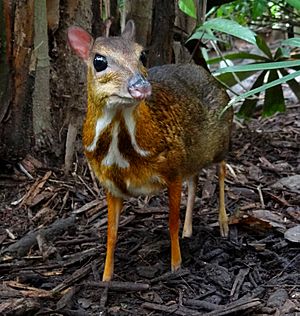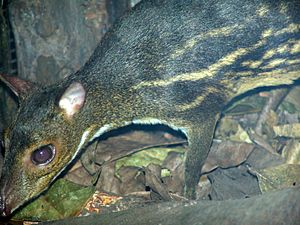Mouse deer facts for kids
Mouse deer, also called chevrotains, are super tiny hoofed mammals. They are the smallest hoofed animals in the whole world! Imagine an animal about the size of a rabbit, but with tiny hooves instead of paws. Some species are so small they can fit in your hands! But don't let their size trick you; they are very quick and can move easily.
There are about ten different kinds of mouse deer. Each kind has its own special features. They belong to a family called Tragulidae. These amazing creatures live in different parts of Asia and Africa. You can find them in many places, from thick forests to open grasslands.
Contents
What Do Mouse Deer Look Like?
Mouse deer come in different sizes, depending on the type. The smallest one is the Lesser Malay Mouse deer (Tragulus kanchil). It can be as short as 40 centimeters (about 16 inches) long. It might weigh only about 1 kilogram (about 2.2 pounds).
Bigger types can grow up to 75 centimeters (about 30 inches) long. They can weigh up to 8 kilograms (about 18 pounds).
They have a slim body with long, thin legs. Their fur is usually reddish-brown, brown, or grayish-brown. These colors help them blend in perfectly with their forest homes. They have small, pointy ears and big, bright eyes. Their hooves are small and sharp. This helps them move easily through the thick plants in the forest.
Where Do Mouse Deer Live?
Mouse deer live in many different places across Asia and Africa. They really like thick forests. But you can also find them in grasslands, wet swamps, and even farm areas.
- Asia: Many types live in Southeast Asia. This includes countries like Malaysia, Indonesia, Thailand, and Vietnam. Other types are found in India, Sri Lanka, and parts of China.
- Africa: African mouse deer live in parts of central and western Africa.
Mouse deer usually live where there are lots of vegetation. This gives them plenty of food and safe places to hide.
What Do Mouse Deer Eat?
Mouse deer are herbivores. This means they only eat plants. They mostly eat leaves, fruits, new buds, and other plants. They are "browsers," which means they carefully pick the plants they want to eat. They often look for food early in the morning and late in the evening. They have a simple digestive system compared to bigger animals like cows or deer.
They are quite picky about their food. They prefer certain types of plants over others. What they eat changes with the seasons and what food is available. They help spread plant seeds around their homes.
How Do Mouse Deer Behave?
Mouse deer are shy and hard to spot in the wild. They are very quick and can dart through thick plants easily.
They talk to each other using different sounds. These sounds include whistles, snorts, and barks. They use these sounds to warn others about danger or to find a mate. They also use scent marking to communicate. They leave their smell on trees and other things.
During mating season, male mouse deer might fight over their territory. They use their sharp canine teeth to defend their space. But these fights are usually not serious and rarely cause injuries.
Reproduction and Life Cycle
Female mouse deer usually give birth to one baby, called a fawn. The fawn is born fully developed. It can walk soon after it is born. The mother takes care of the fawn for several months. She gives it milk and keeps it safe.
How long a mouse deer lives depends on its type and where it lives. But they usually live for several years in the wild.
Are Mouse Deer in Danger?
Many types of mouse deer are facing problems. Their homes are being lost, and they are being hunted. Some types are listed as vulnerable or endangered. People are working hard to protect these amazing little animals and their homes. These efforts include protecting their habitats, stopping poaching, and teaching people about them.
Cool Facts About Mouse Deer
- Mouse deer are solitary animals. This means they like to live alone.
- They are most active when the sun is coming up or going down.
- They tap their small feet on the ground to send signals to each other.
- Some types can stay underwater for a long time to hide from animals that hunt them.
Images for kids






